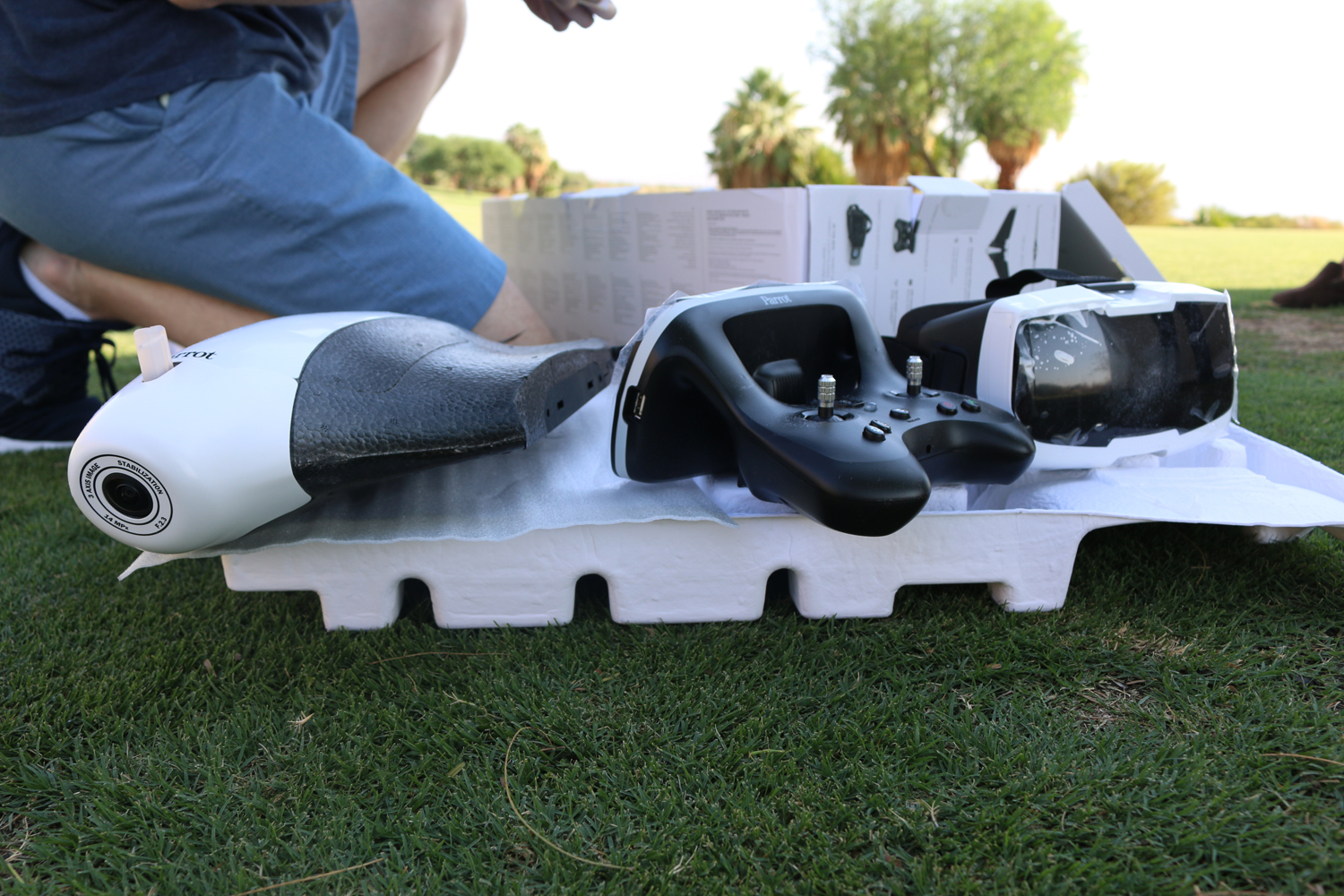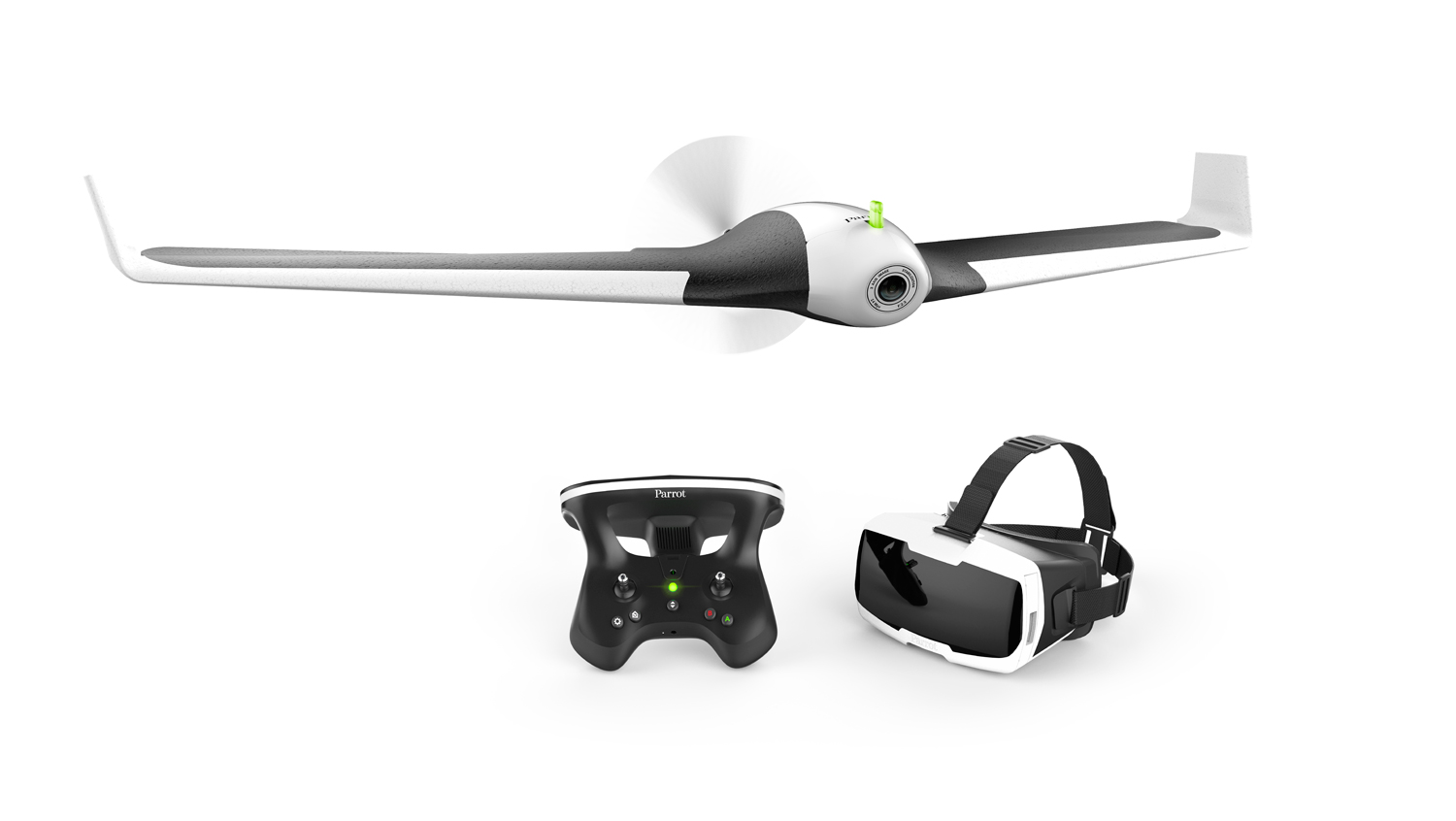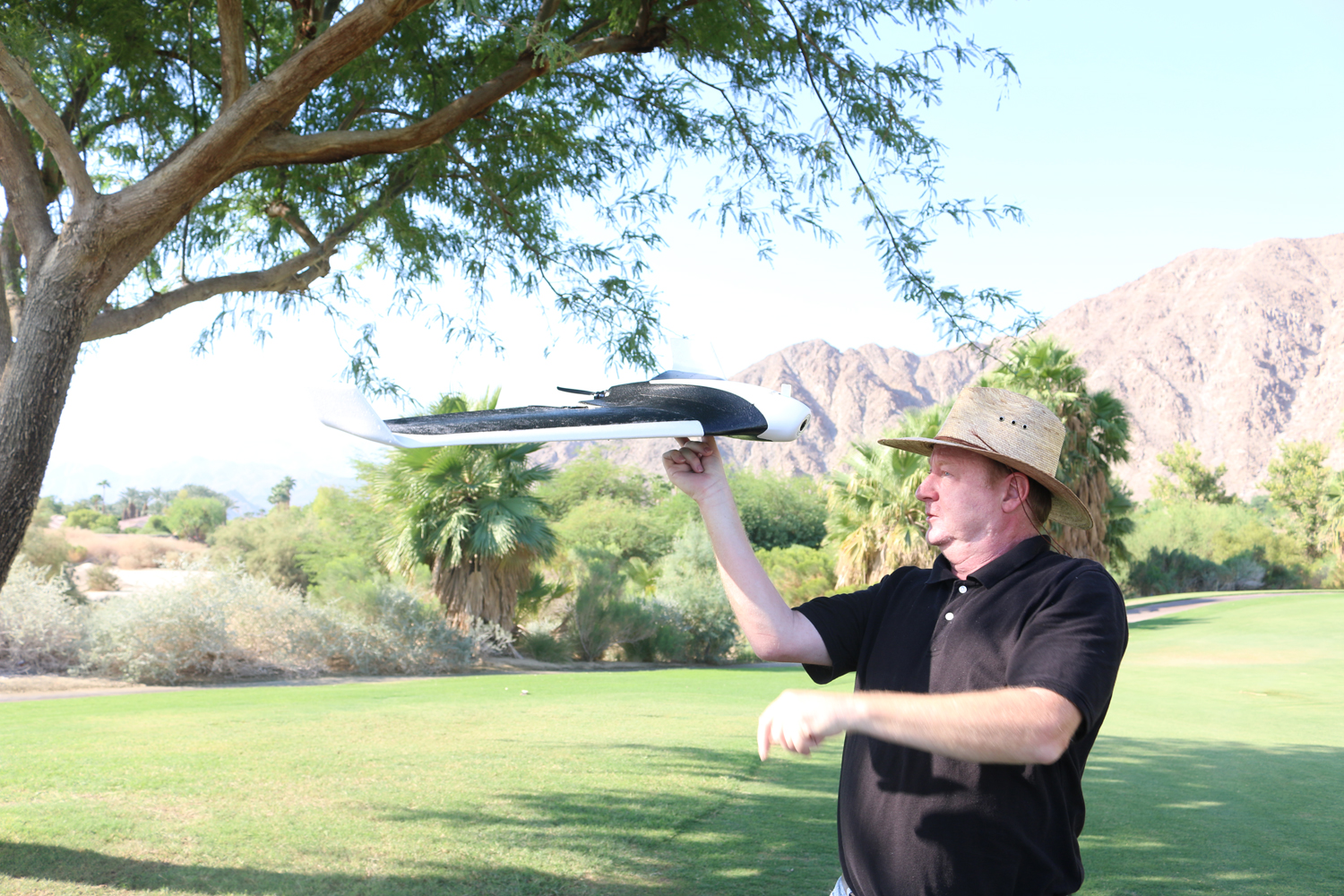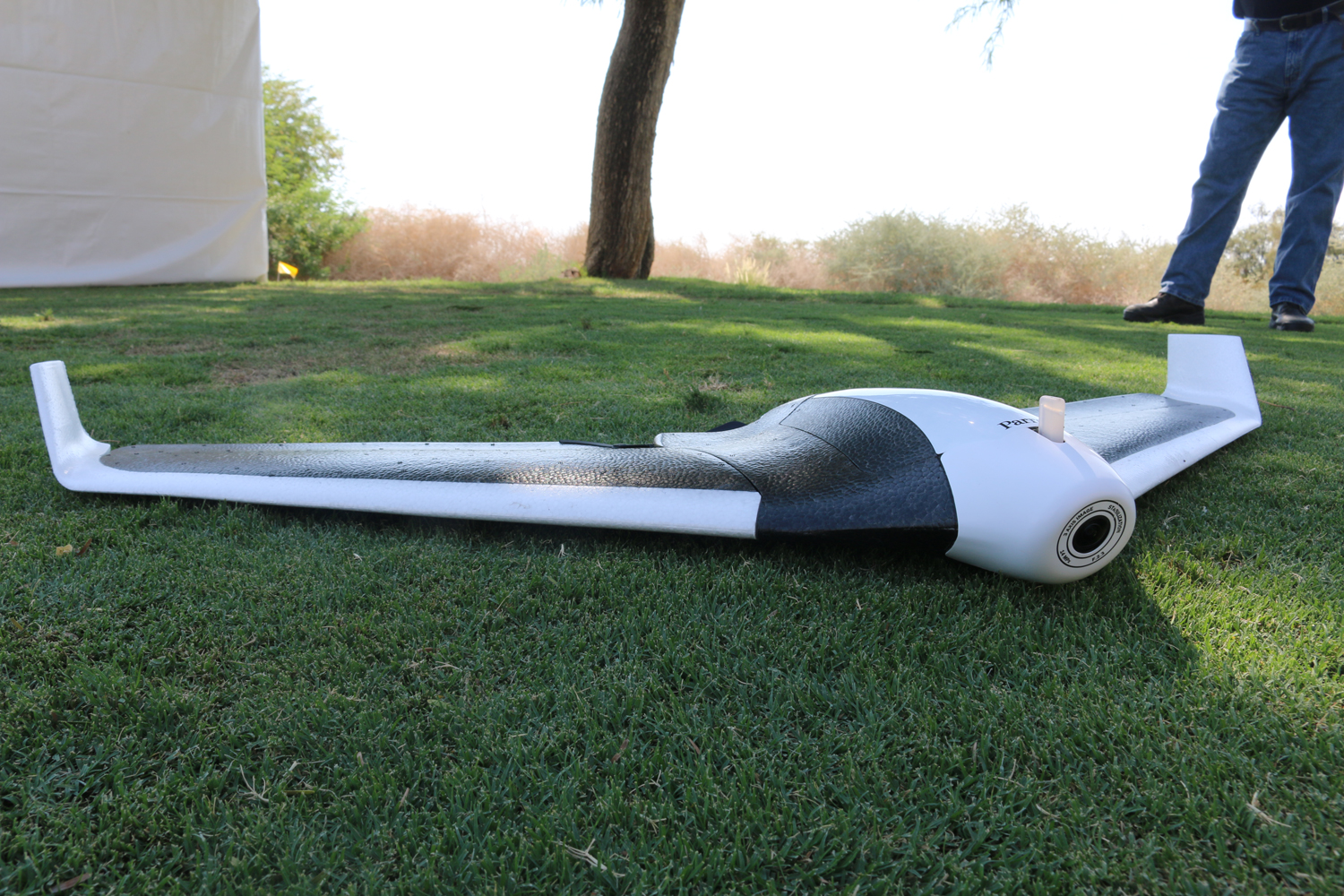Disco Drone's Headset Makes it Feel Like You're Soaring
Parrot's Disco is an impressive fixed-wind drone, but it's the headset that lets you see what the drone sees that really stands out.
PALM SPRINGS, Calif. — I was soaring over the SilverRock Resort, breezing over the sand traps and water hazards around the 13th fairway. A slight bank to my left, though, and I found myself circling toward the mountains that loom over the course. A quick course correction, later, I was back on track, circling once more over the golf course and staring out at the desert just beyond it. And I did all that without ever leaving the ground.
That bird's eye view came to me courtesy of Parrot's Disco, with the drone's 14-megapixel camera streaming images to a first-person view headset strapped onto my head. As impressive as the Disco is — and drone hobbyists will really enjoy flying this fixed-wing aircraft, it's the CockpitGoggles headset and the eye-in-the-sky view they afford that really steal the show.
MORE: Best Drones Tested and Rated
Parrot plans to release the Disco drone, along with the CockpitGlasses headset and a more compact version of its Skycontroller remote control in September for $1,299. I got a chance to take the fixed-wing drone up for a test flight and came away impressed with both the Disco and the sky-high views it offers.
Getting started

There's plenty to like about the Disco, starting with the fact that it goes pretty fast — up to 50 mph — and stays in there air for a long time, with 45 minutes of flight time. But the first thing you notice when you pop open the box, as we did on the SilverRock golf course, is how quickly you can get up and flying. The drone's wings come detached in the box; you pop them into place and use a bracket to secure them. Plug the Skycontroller 2 into your phone, and slide that phone into the included headset, and you're ready to fly.
Taking flight is simply a matter of pushing a switch on the upper part of the drone's nose, and then pressing the takeoff/landing button on the Skycontroller unit as you hold one of the Disco's wings with your free hand. The rear propeller will start to turn, then really begin to rev.
That's when you fling the Disco skyward, and its autopilot features will take over. The drone will fly forward, climbing to a height of 164 feet at which point it will start to circle above you, until you're ready to take over with the toggles on the Skycontroller.

The process sounds more complicated than it actually is. I found it simple enough to launch the Disco, even while wearing the CockpitGlasses headset, thanks to that device's see-through feature. Using see-through, you can switch from the Disco's point of view to the rear camera of the phone inserted inside the headset. See-through comes in hand whenever you need to glance down at the SkyController 2's joysticks and buttons and you don't want to take off the headset.
Get instant access to breaking news, the hottest reviews, great deals and helpful tips.
Meet CockpitGlasses, Disco's best feature
You can fly Disco without the CockpitGlasses on using just your line of sight, though it's not nearly as much fun. The headset works a lot like Samsung's Gear VR headset or a more high-tech Google Cardboard viewer, using your Android or iOS phone to show you exactly what the Disco is capturing with the wide-angle camera on its nose.

Parrot says its headset will work with many current phones, specifically citing the latest iPhones and Galaxy handsets as compatible with CockpitGlasses. During the Disco launch event, Parrot CEO Henri Seydoux also mentioned the Nexus 6, Xperia Z5 and LG G3 as devices that worked with Disco's headset.
The Disco streams HD video to the CockpitGlasses, and based on what I saw, during my test flights, the view is pretty glorious. I could clearly see the golf course below me, the mountains to the east, and even the neighborhoods surrounding the golf course. The only time I noticed any latency was when I banked the drone hard in either direction, with the video stream hurrying to keep up with my flight.

Which is not to say that the view from the CockpitGlasses doesn't occasionally become disorienting. Switch the drone into Loiter mode — that's where the Disco flies in circles while you figure out where you want to go next — and the constant spinning might make you feel like you're on one of those spinning rides the county fair. A few minutes of video from a Disco in Loiter mode left me a little bit queasy, but that was the only time I didn't enjoy the view.
After all, when you direct your drone to start descending rapidly, and you can watch the plunge unfold before you, you'll wonder why all drones don't come with their own FPV headset.
The headset offers more than just a great view. It also displays stats about your flight in a helpful heads-up style: on the left you can see the Disco's speed, altitude and distance from you, while the right shows the percentage battery life remaining for both the drone and the remote control unit.
In Control with Parrot Skycontroller 2

Parrot's original Skycontroller took some knocks in our Parrot Bebop 2 review for being a bit on the bulky side. The Skycontroller 2 remote shipping with Disco feels more compact, and the controls look like something you'd use with an Xbox. A right joystick made the Disco bank, elevate and descend while the left joystick controlled speed and activated the Loiter mode.
Besides the takeoff/landing button, a home button could call back a Disco that's flown too far away, while right and left triggers on the Skycontroller's side activated a radar feature for showing the drone's location relative to you and the see-through feature, respectively. The Skycontroller 2 also has programmable A and B buttons.
If I have a beef with the Skycontroller, it's that I found I got the cleanest stream from the Disco when the panel of antennas atop the remote control unit was facing toward the drone. If the Disco flew behind me, I would occasionally lose contact with it, forcing me to re-orient myself to reconnect with drone.
I'm not a particularly skilled pilot, but I found the joysticks easy to manage, even if I occasionally would bank to hard or ascend a little more rapidly than I should have. Parrot has built some smarts into the Disco to help all-thumbs pilots like myself: assisted pilot features that can keep the Disco on-course. Turn left or right — even severely as I was prone to — and the assisted pilot feature maintains a steady altitude while keeping the drone's flight constant. "It's more easy than a bicycle," Seydoux said during the Disco launch event.

I did manage to crash the Disco, and in quite a spectacular way. After some not entirely successful attempts to bring the drone in for a landing — I tended to double-tap the takeoff/landing button which causes the Disco to pull out of its landing — I tried circling back around for one final run. I decided to remove the CockpitGlasses to land the drone by sight, and that proved to be a crucial mistake.
Immediately after taking off the headset, I thought the drone was flying toward me and accelerated; as it turned out, the drone was heading in the opposite direction, and by the time I tried correcting course, it slammed into a mountain that abuts the golf course. ("I swear, officer, the mountain just jumped in front of me!")
My one consolation? I wasn't the only person in our test group to crash a drone, though other crashes were of a more conventional nature, as pilots misjudged landing attempts.
There's some good news for Parrot, though: the Disco withstood our best attempts to smash it into palm trees, mountains and whatever other objects were nearby. Though the Disco hit the tree relatively head-on, it sustained only a few minor nicks on one of its wings. Credit the expanded Polypropylene materials and carbon tube reinforcements Parrot uses in the Disco's design.
Other Features
The FreeFlight Pro app for your mobile phone not only gives you control over the Disco — you can set limits on how the drone goes as well as activate a return home feature that brings the drone back to its approximate take-off point — but a more advanced feature is available via in-app purchase. The $20 Flight Plan add-on lets you map out a course for the Disco, including how high it will circle at each waypoint and exactly where it will land.
More experienced pilots than those of us who can't avoid mountains can do away with the pilot-assist features altogether by attaching an RC transmitter to the Disco's on-board computer kit. That allows you to perform more sophisticated aerial tricks like barrel rolls, which is really something to see.
The Disco seems to deliver on Parrot's promised flight time. We spent a couple hours out in the desert flying Parrot's drone and only needed three battery changes.
Outlook

The Disco cuts a striking figure when it glides through the sky. At times while others were taking their turn flying the drone I would glance up and mistake the Disco for a bird. It's the first-person view that really stands out, though, making the Disco appealing to drone hobbyists who want a different point of view on their next flight.
Philip Michaels is a Managing Editor at Tom's Guide. He's been covering personal technology since 1999 and was in the building when Steve Jobs showed off the iPhone for the first time. He's been evaluating smartphones since that first iPhone debuted in 2007, and he's been following phone carriers and smartphone plans since 2015. He has strong opinions about Apple, the Oakland Athletics, old movies and proper butchery techniques. Follow him at @PhilipMichaels.

